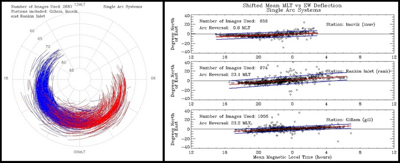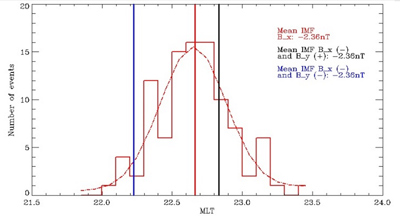
2014 THEMIS SCIENCE NUGGETS
A Survey of Quiet Auroral Arc Orientation and the Effects of the Interplanetary Magnetic Field
by D. Megan Gillies, University of Calgary
| Figure 1. (Left) THEMIS mosaic showing an auroral display with images from across the Canadian region and Alaska overlaid with the geomagnetic field lines. (Right) finer scale structuring of the aurora inset with the AuroraMAX camera visible from the ground. Image courtesy of Astronomy North. |
Introduction
Understanding the space environment presents a massive challenge by virtue of the immense volume of near-Earth space. Fortunately, many of the same energetic processes that drive dynamics in near-Earth space are also projected on the upper atmosphere as optical emissions in the form of aurora and airglow. Study of the aurora provides a window into the workings of the vast space environment – most of which would otherwise remain invisible. This is a very exciting time for auroral science. Due to major national and international initiatives, there are more than 30 all-sky imagers (ASIs) operating in Canada. For the first time in observing history, this enables continent-scale observations of the aurora (please see Figure 1) allowing scientists to delve into the details of how auroral structures organize and couple to near-Earth space. Where auroral arcs form, how they are oriented with respect to Earth’s magnetic field, and how often they occur as a single arc or as part of a multiple arc system all yield important clues on how Earth’s magnetosphere works and how it relates to the bigger Sun-Earth system.
| Figure 2. (Left) Auroral arc tilt as a function of local time and magnetic latitude for single-arc systems. (Right) Arc tilt as a function of MLT for single-arc systems for the (top to bottom) INUV, RANK, and GILL stations. |
Results
We examine how auroral arcs are aligned with lines of constant geomagnetic latitude. As we show in Figure 2 (left), examination of the single-arc systems shows arcs are tilted and the degree of the tilt is dependent upon their magnetic local time (MLT). For each arc classified, the arc tended to deflect equatorial of the geomagnetic field line in the dusk region and poleward towards dawn. We see a clear relationship between the direction and magnitude of the arc tilt and MLT as seen in Figure 2 (right). The point where, on average, the arcs go from equatorial to poleward tilt is called the reversal point. This reversal point is clear and shifts toward the morning sector with increasing latitude. We also explore the effect of the interplanetary magnetic field (IMF) on the formation of arcs and on the arc reversal point. As expected, we found that arcs occur preferentially for higher geomagnetic activity levels at lower altitudes. We also found that the sign of the IMF y-component shifts the reversal point towards dusk for a negative orientation and towards dawn for a positive orientation (shown in Figure 3). We repeated the study for multiple-arc systems and found similar results. When comparing the single and multiple arc systems we found that they were comparable in number and that there was little to no difference in geomagnetic activity levels during single or multiple arc events.
| Figure 3. Subset of negative IMF BX events for the single arc systems recorded by the GILL station were randomly sampled from a set of 479 arcs and the auroral arc tilt reversal point plotted as a function of MLT. A Gaussian was fitted to the sampling and a mean arc tilt reversal point of 22.6 MLT is established. The set was further subdivided into positive and negative IMF By events and the mean auroral arc tilt reversal positions are determined to be 22.8 MLT and 22.2 MLT, respectively. |
Conclusion
We surveyed and classified over 7500 auroral arc images spread across five stations during a four-year period performing one of the largest scale surveys of auroral arc activity in the Northern hemisphere. We analyzed the background IMF and geomagnetic conditions, arc multiplicity, and arc tilt. We several important findings which are summarized below:
- The occurrence rate of multiple arc systems is comparable to that of single arcs, indicating that arc theories must explain - or at least be consistent with - the formation of multiple arcs.
- Both single and multiple arcs tend to deflect a few degrees to the south-east prior to 23 MLT, and to the north-east afterward. The amount of deflection and scatter is greater at more northernly sites.
- Stable auroral arcs are nearly aligned with lines of constant geomagnetic latitude, indicating that their overall morphology is governed by the large-scale structure of the magnetosphere. This behavior is at odds with mechanisms that invoke localized instabilities or resonances in the ionosphere or auroral acceleration region.
- Subtle dependence on arc reversal location is seen with IMF Bx and By -possibly related to a similar dependence with respect to substorm onset location
Reference
Gillies, D. M., D. J. Knudsen, E. F. Donovan, E. L. Spanswick, C. Hansen, D. Keating, and S. Erion (2014), A survey of quiet auroral arc orientation and the effects of the interplanetary magnetic field, J. Geophys. Res. Space Physics, 119, doi:10.1002/2013JA019469.Biographical Note
Dr. D. Megan Gillies is a post-doctoral associate in the Department of Physics and Astronomy at the University of Calgary located in Calgary, AB, Canada. Her current research interests include auroral morphology and field-aligned current generation mechanisms.
 Please send comments/suggestions to
Emmanuel Masongsong / emasongsong @ igpp.ucla.edu
Please send comments/suggestions to
Emmanuel Masongsong / emasongsong @ igpp.ucla.edu



